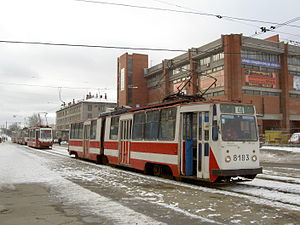
The ER200 was a Soviet electric train built in Riga by Rīgas Vagonbūves Rūpnīca. It was the first high-speed Direct Current intercity Electric Multiple Unit (EMU) train with rheostatic brake. There were two designs. The first design, begun in 1974, was the ER200-1 EMU, and went into commercial operation in 1984. The second design went into operation between Saint Petersburg and Moscow in 1996.

The LM-49 is the Soviet motor four-axle tramcar. The first prototype of this vehicle was built in 1949 at the Leningrad Wagon Repair Plant. "LM" means Leningrad Motor tramcar. These tramcars were utilized in Leningrad itself and some other Soviet cities such as Minsk, Gorky], Novokuznetsk and Magnitogorsk. VARZ produced in total 287 LM-49s for Leningrad and 113 for other cities.
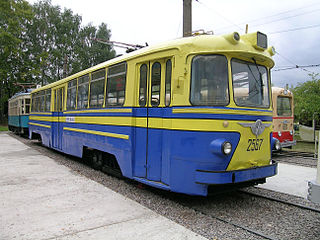
The LM-57 is the Soviet motor four-axle tramcar. First prototype of this vehicle was built in 1957 at the Leningrad Wagon Repair Plant. "LM" means Leningrad Motor tramcar. The VARZ produced nearly 800 LM-57s in 1957–1968.

Trams in Saint Petersburg are a major mode of public transit in the city of Saint Petersburg, Russia. Saint Petersburg once had the second-largest tram network in the world, consisting of about 340 kilometres (210 mi) of unduplicated track in the late 1980s. However, since 1995 the tramway network has declined sharply in size as major portions of track were removed, particularly in the city centre. Saint Petersburg lost its record to Melbourne, Australia. While it still had 285 kilometres (177 mi) of length in 2002, by early 2007 the tram network's had declined to just over 220 kilometres (140 mi), and by the 2010s operated on just 205.5 kilometres (127.7 mi) of network.

The Tramway Français Standard (TFS) is a type of tram designed and manufactured by Alstom for use on various tramway systems in France. The TFS is no longer in production, having been superseded by the Alstom Citadis range of tramcars.

LVS-97 (71-147) is a Russian-made six axle tram. LVS denotes «Ленинградский Вагон Сочленёный» which is an articulated tramcar, made in St. Petersburg. It was produced at the Petersburg Tram Mechanical Factory from 1997 through to 2004.

For servicing suburban commuter lines, electrified on 25 kV, AC, the Railcar Manufacturing Plant of Riga produced ER9, then ER9P and other modifications of electric trainsets in the 1962-2002 period. The mass production of these trains had begun in 1964.
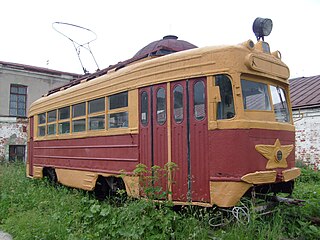
KTM-1 is a Soviet-made two-axle tram with a metal body. KTP-1 is a two-axle trailer car to intended to work under KTM-1 traction. It was the first Soviet-made tram to be originally single ended, as well as designated to work on looped lines. It was the first Soviet-made tram with wide four-segment folding doors and bigger passenger storage spaces. Doors were driven pneumatically.
Petersburg Tram Mechanical Factory (PTMF) was one of the leading manufacturers of tramcars in Russia and the CIS-countries located in Saint Petersburg. As the only tram manufacturing plant in Russia for several decades, it was the sole supplier of rolling stock for the tram system in St. Petersburg.
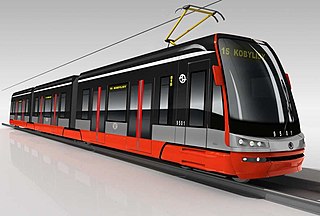
Škoda 15T is a 100% low-floor multiple-unit tram developed by VUKV a.s. and built by Škoda Transportation in Pilsen for the Prague tram network. It was a successor to the Škoda 14 T, featuring articulated bogies and more power to correct for problems found during the operation of the 14 T. The 15T has articulated bogies at either end of the train, and Jacobs bogies between the segments. The tram has two double-doors in each segment to allow fast boarding of passengers, and one extra side door leading to the driver's cabin.

Tatra KT4 is the name of a four-axle type articulated tramcar developed by the Czech firm ČKD Tatra. The first pre-production vehicles entered service in Potsdam in 1975, with the first production vehicles in 1977. A total of 1,747 units were built, with initial deliveries to East Germany (DDR) and later to the USSR and SFR Yugoslavia. KT4 variants were built for both standard gauge and metre gauge tramways. Production of the KT4 tramcar was halted in 1991 due to worldwide economic and political changes at the time. Production was briefly resumed in 1997 to construct the last 20 units for Belgrade, Serbia.

The South African Railways Class 7E is an electric locomotive. South African Railways placed 100 Class 7E electric locomotives with a Co-Co wheel arrangement in service in 1978/79. They were the first 25 kV AC locomotives to enter service in South Africa.
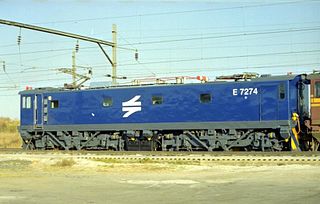
The Spoornet Class 7E4 of 2001 is a South African electric locomotive.
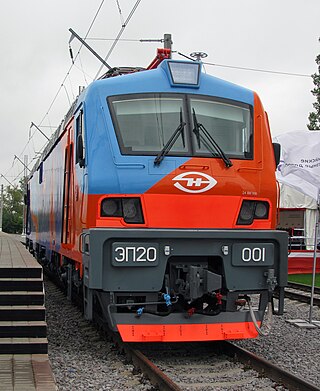
The EP20 (ЭП20) is a type of 6 axle Bo'Bo'Bo' electric passenger locomotive being built for Russian Railways by Transmashholding's Novocherkassk Electric Locomotive Plant. The locomotive was designed by TRTrans, a joint venture between Transmashholding and Alstom.

The VL85 is a Soviet built electric mainline freight locomotive manufactured at the Novocherkassk Electric Locomotive Plant (NEVZ) and designed under the management of V.Ya.Sverdlov (ru:В.Я.Свердлов).

The Transnet Freight Rail Class 20E of 2013 is a South African electric locomotive.

The Indian locomotive class WCAM–3 is a class of dual-power AC/DC series electric locomotives That was developed in 1997 by Bharat Heavy Electricals Limited used in the Indian Railways system. They are the third locomotives from the WCAM class. The model name stands for broad gauge (W), DC Current (C), AC Current (A), Mixed traffic (M) locomotive, 3rd generation (3). They entered service in 1997. A total of 53 WCAM-3 were built at BHEL between 1997 and 1998, which made them the most numerous class of mainline dual-power AC-DC electric locomotive. They were specifically designed for use by Central Railways in the Ghat section towards Nashik and Pune.

71-931 "Vityaz" is a Russian three-unit six-axle 100% low-floor tram car created by LLC "PK Transportnye Sistemy" and manufactured in cooperation by PK TS and Transmashholding at the facilities of the Tver Carriage Works. Currently exists in two versions: the basic model Vityaz and 71-931M Vityaz-M modification with modified front and rear mask, different interior and Russian-designed traction motors. In operation in St. Petersburg, Krasnodar and Moscow's Bauman, Oktyabrskoye and Rusakov depots.

The Indian locomotive class WAG-4 is a class of 25 kV AC electric locomotives that was manufactured by CLW in the late 1960s for Indian Railways. The model name stands for broad gauge (W), AC Current (A), Goods traffic (G) engine, 1st (1). A total of 186 WAG-4 locomotives were built by The European Group 50 Hz Group/European Group/50 Cycles Group (consortium) between 1967 and 1969. They entered service in 1967.

The KTM-5, later known as the 71-605, is a Soviet tram model manufactured by UKVZ. First introduced in 1963, the KTM-5 was mass-produced between 1969 and 1992, with a total of 14,991 tramcars being made. KTM-5 trams were built exclusively for the Soviet Union, and therefore are currently only operating in post-Soviet states.


